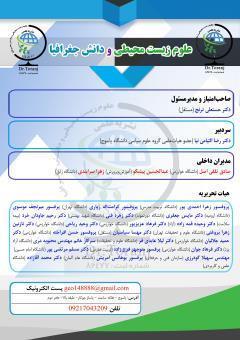ارزیابی چرخه زندگی اثرات و زیستمحیطی نیروگاه بادی فراساحلی
محورهای موضوعی : علوم زیست محیطیامید سلمانی نژاد 1 , سید مجید کشاورز 2
1 - دانشگاه فنی حرفه ای
2 - دانشگاه فنی و حرفه ای استان یاسوج، ایران،
کلید واژه: منطقه اعماق دریا, باد دریایی, نیروگاه بادی فراساحلی , ارزیابی چرخه حیات, تأثیرات محیطی, انتشار گازهای گلخانهای, ,
چکیده مقاله :
یک نیروگاه بادی یا مزرعهٔ بادی، مجموعهای از چندین توربین بادی است که در یک مکان قرار گرفتهاند. یک نیروگاه بادی بزرگ میتواند شامل چندصد توربین بادی باشد. چنین مجموعهای میتواند بر روی دریا قرار گرفته باشد. نیروی بادی شناور دریایی، یک فناوری نوظهور در صنعت باد فراساحلی، توجه فزایندهای را به دلیل پتانسیل خود برای همکاری با سایر انرژیهای تجدیدپذیر برای کربنزدایی سیستمهای انرژی به خود جلب کرده است. اثرات زیستمحیطی مزرعه بادی دریایی شناور در مناطق اعماق دریا باید در نظر گرفته شود و روشهایی برای تقویت اثر کمکربن باید ابداع شود. مطالعات کمی برای ارزیابی اثرات زیستمحیطی مزرعه بادی شناور دریایی انجامشده است، اما مقیاس این مطالعات نسبتاً کوچک بود. مزرعه بادی فراساحلی در آینده، دادههای پایه بیشتری برای بهبود قابلیت اطمینان LCA باید جمعآوری شود. اثرات مزرعه بادی دریایی شناور بر اکولوژی دریایی و ویژگیهای فیزیکی جوی باید در عمق موردبررسی قرار گیرد. کلیدواژهها: منطقه اعماق دریا،باد دریایی،نیروگاه بادی فراساحلی ،ارزیابی چرخه حیات،تأثیرات محیطی،انتشار گازهای گلخانهای،
A wind power plant or wind farm is a collection of several wind turbines located in one place. A large wind farm can consist of several hundred wind turbines. Such a complex can be located on the sea. Offshore floating wind power, an emerging technology in the offshore wind industry, has attracted increasing attention due to its potential to cooperate with other renewable energies to decarbonize energy systems. The environmental effects of floating offshore wind farms in deep sea areas should be considered and methods to enhance the low-carbon effect should be devised. Few studies have been conducted to evaluate the environmental effects of offshore floating wind farms, but the scale of these studies was relatively small. In the future offshore wind farm, more baseline data should be collected to improve the reliability of LCA. The effects of floating offshore wind farm on marine ecology and physical atmospheric properties should be investigated in depth. Keywords: deep sea area, offshore wind, offshore wind farm, life cycle assessment, environmental impacts, greenhouse gas emissions,


